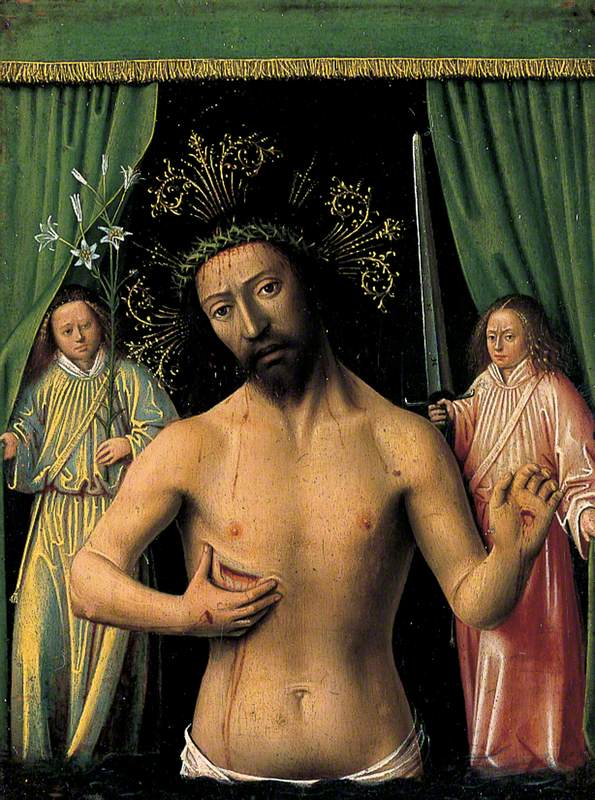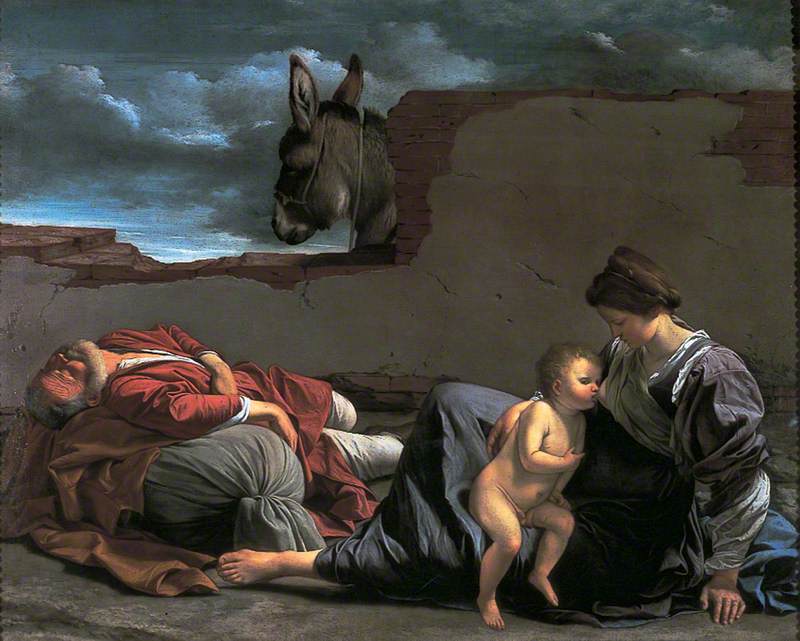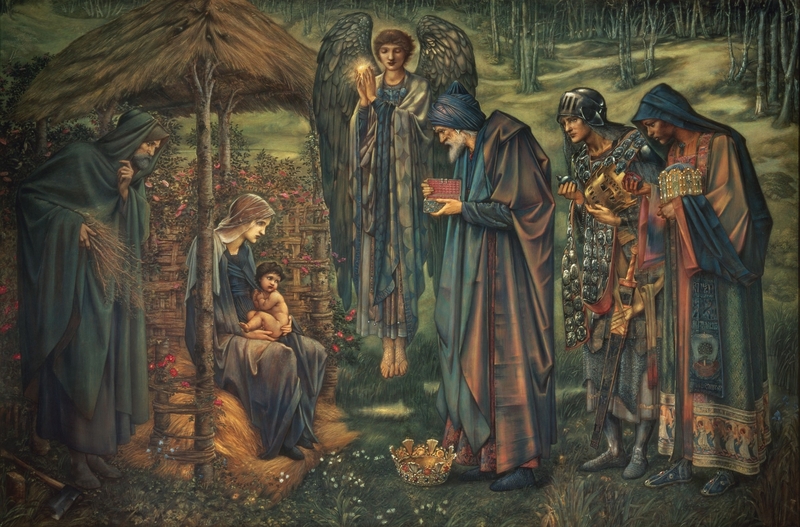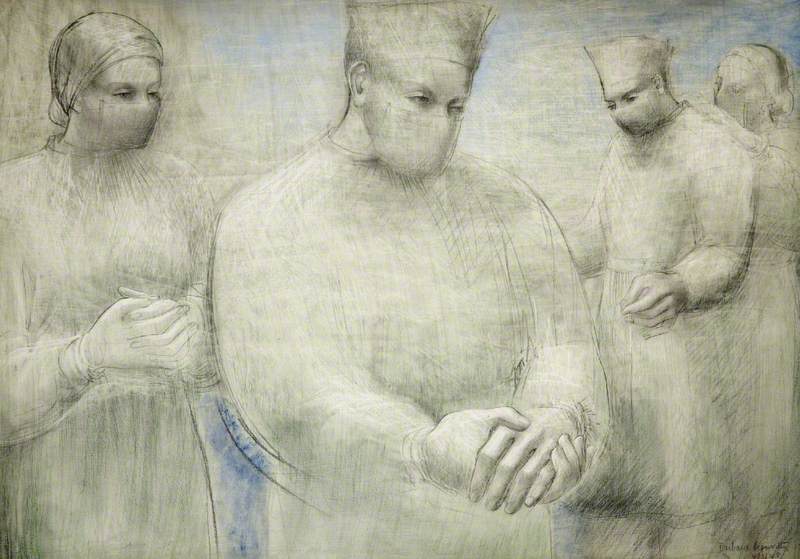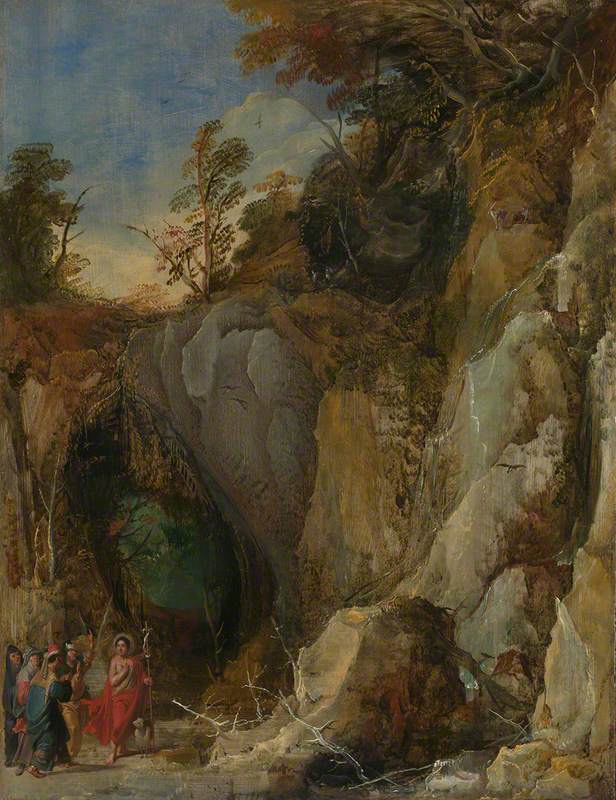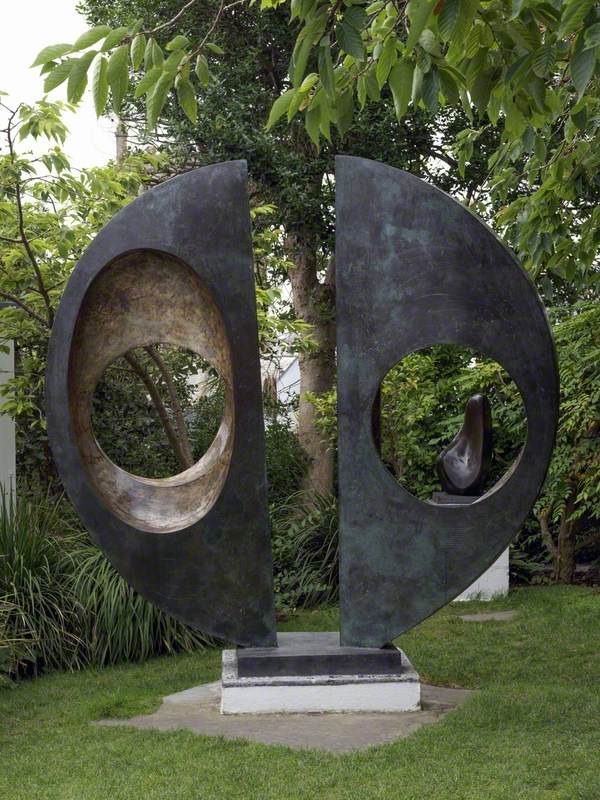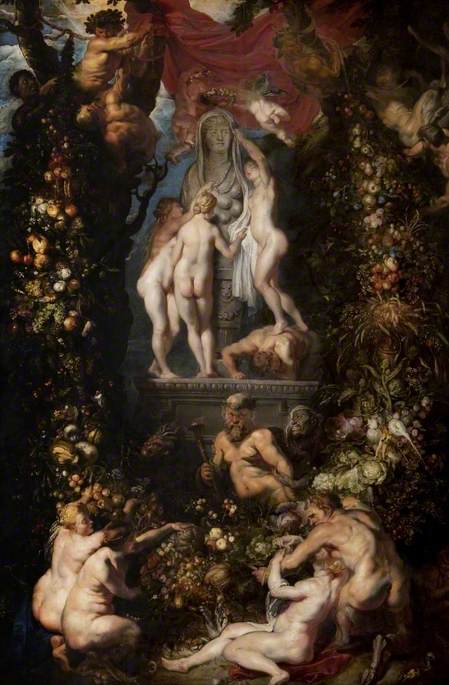Birmingham Museums cares for the city’s vast and diverse collection of around 1 million objects on behalf of Birmingham and its communities. It provides a wide range of activities at nine venues across the city. Birmingham’s art collection spans eight centuries. It includes an important collection of Italian Baroque paintings and the largest holdings of art and design by the Pre-Raphaelites and their followers anywhere in the world.
Art Unlocked is an online talk series by Art UK in collaboration with Bloomberg Philanthropies. This Curation is based on a talk by Victoria Osbourne, Curator (Fine Art) & Curatorial Team Leader, on 17th August 2022. You can find a recording at https://youtu.be/kxfg9Ixlkos
-
Christ as the Man of Sorrows c.1450
This tiny painting, smaller than a postcard, was made as a focus for private prayer. Two angels draw back a curtain to reveal the figure of Christ displaying the wounds of his Crucifixion. He gazes out at the viewer, directly appealing to them to meditate on his sufferings and repent their sins.
The picture was purchased with money left to the city by Birmingham newspaper proprietor and philanthropist John Feeney (1839–1905). The John Feeney Charitable Trust still exists today, supporting local causes in the city relating to the arts, heritage and open spaces. In 2018 it helped fund the creation of a new frame for this picture.
Petrus Christus (c.1410–c.1475)
Oil on panel
H 11.2 x W 8.5 cm
Birmingham Museums Trust
-
The Rest on the Flight into Egypt c.1620
Birmingham holds one of the UK’s finest collections of 17th-century painting outside London, with a particular strength in the Italian Baroque. Gentileschi’s The Rest on the Flight into Egypt was the first work acquired for this part of the collection, bought at auction in 1947 for 500 guineas (around £20,000 today). It depicts the escape of Mary, Joseph and the young Jesus from Judea into Egypt, following Herod the Great’s threat to kill the child. The Holy Family are fugitives and refugees, and Gentileschi’s treatment of the subject emphasises their humanity: their vulnerability and exhaustion, and the tender relationship between mother and child as Mary feeds Jesus at her breast.
Orazio Gentileschi (1563–1639)
Oil on canvas
H 175.6 x W 218 cm
Birmingham Museums Trust
-
Autumn 1605–1610
This painting was in store and in poor condition until it featured on BBC4’s programme Britain’s Lost Masterpieces in 2019. Over several months it went through a process of research, scientific analysis, cleaning and restoration. This transformed the picture, revealing an amazingly detailed and subtle landscape under the heavy overpaint and layers of discoloured varnish.
The landscape is by de Momper and the figures by an artist in Brueghel’s workshop, if not by Brueghel himself. De Momper and Brueghel often worked together: they collaborated on nearly 60 known paintings. This picture was part of a set representing the four seasons. It shows cider making in autumn: harvesting the apples, pressing them, and storing the cider in barrels.
Joos de Momper the younger (1564–1635) and Jan Brueghel the elder (1568–1625) (workshop of)
Oil on oak panel
H 30 x W 50 cm
Birmingham Museums Trust
-
The Star of Bethlehem 1887–1891
Born in Birmingham in 1833, Edward Burne-Jones is the most famous artist associated with the city. The Star of Bethlehem was commissioned from him by the Birmingham Corporation in 1887 to hang in the new Museum and Art Gallery, which had opened two years before. Burne-Jones based the design on a tapestry that he and William Morris had made for the chapel of Exeter College, Oxford, where they studied together in the 1850s. Painted on ten sheets of the largest watercolour paper then available, laid on canvas, The Star of Bethlehem is thought to be the largest watercolour in the world. When the picture was brought from London to Birmingham in 1891, the crate was so large that it needed its own train carriage!
Edward Burne-Jones (1833–1898)
Watercolour & bodycolour with scraping
H 299 x W 423 cm
Birmingham Museums Trust
-
Prelude I 1948
This is one of a series of nearly 80 hospital drawings that Barbara Hepworth made between 1947 and 1948. Allowed access to operating theatres with a sterilised notebook and pen, she made sketches on the spot which she later worked up into finished compositions. Some of the drawings in the series, like this one, show surgical teams preparing themselves before beginning a procedure. With their faces and bodies largely hidden by masks and surgical gowns, Hepworth focuses our attention on their eyes and, above all, on their sensitive, flexible hands. Hepworth compared the skill and precision of the surgeons and their exact, coordinated movements in the operating theatre to the dexterity of artists and sculptors in their work.
Barbara Hepworth (1903–1975)
Oil & pencil on gesso ground board
H 40 x W 52 cm
Birmingham Museums Trust
-
Souvenir 9 (Queen Victoria) 2019
One of Locke’s early memories is a statue of Queen Victoria in the centre of Georgetown, Guyana, where he grew up. Damaged in an anti-colonial protest in 1954, it was relegated to the city’s Botanic Gardens following Guyana’s independence but controversially re-erected in its old position in 1990. Locke often returns to images of Queen Victoria in his practice, including reimagining a bronze statue of her for the Commonwealth Games.
Locke’s work often explores colonial histories and legacies. In his Souvenir series, he dresses original 19th-century ceramic busts of British royalty in elaborate regalia. This piece includes coins, chains and medals, and an image of an ivory mask looted during the British sacking of Benin City in 1897.
Hew Locke (b.1959)
Mixed media on antique parianware
H 44.1 x W 27 x D 26 cm
Birmingham Museums Trust
